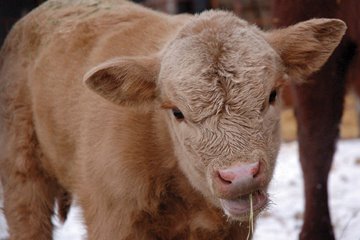
by Debbie McMillin
Exports of live cattle to the U.S. in 2008 have varied. Overall exports are larger than the same time in 2007, however that includes an increase in the number of feeder cattle exported and a decrease in the number of fed cattle heading south. In addition, slaughter cows, butcher bulls and breeding stock have all been added back into the mix again in 2008.
Feeder cattle exports in 2008 have been large. However exports tapered off after the July 15th date passed in which the cattle exported into the U.S. were grandfathered into the U.S. meat system, bypassing any country of origin labeling hassles.
It would appear that buyers in the U.S. have had the chance to look at what will be involved in the new COOL legislation and it seems that the need for Canadian feeder calves is outweighing the additional hassles that will be involved a multi-origin beef label.
The August exports of feeder cattle started out slow but by the last two weeks of the month, exports were running much above the equivalent weeks last year.
According to USDA data, the first week of September saw the feeders heading south at 15,914 head, much more than the same week in 2007, at 10,440 head exported. To date in 2008 there have been 426,461 head of feeder cattle exported to the U.S. - 55% more than the comparable weeks in 2007.
Fed cattle exports have been slower. A smaller number of fed cattle available and narrower cash to cash basis have been factors in fewer fed slaughter cattle crossing the border. Up to early-September, the number of fed cattle exported to the U.S. for slaughter was 451,943, down 15% from the same time period in 2007. Fed exports will likely decline further as the September 30th implementation date for COOL in the U.S. arrives. The additional costs associated with labeling beef from Canadian slaughter cattle will likely widen the basis and slow exports, although a decline in the Canadian dollar could help offset some of the affects.
Non-fed trade to the U.S. has been very active since the start of the year. Demand for grinding and trim products has been strong. Tight supplies throughout North America (due to a smaller U.S. cow herd) has increased the demand for Canadian cull cattle. Also, the weaker U.S. currency in 2008 increased U.S. exports to other countries, which also added to the need for additional cow meat south of the border.
A total of 129,606 head of slaughter cows and bulls combined have been exported. Just over 100,000 head of the total is cow exports with the remainder being butcher bulls.
Exports of breeding stock has also resumed this past year. The reopening of the U.S. border to Canadian breeding stock was significant to the purebred producers who have persevered over the past five years waiting to trade genetics with southern breeders again.
Last year after the November date to re-open this element of trade to the U.S., there were just 137 head of breeding bulls exported from then until the end of 2007.
In addition to the breeding cattle, there were 1,464 head of breeding females that were exported in 2007. The numbers continue to grow in 2008. To date the number of breeding bulls exported to the U.S. total 562 head, while females for breeding is at 2,597 head in 2008.


No comments:
Post a Comment